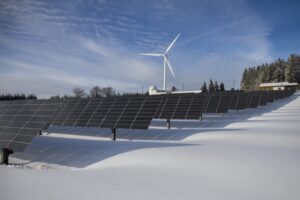- In August 2022, the American Democrats passed a new tax law and energy production.
- This new policy aims to direct new tax credits to strengthen national energy sovereignty with renewable sources.
- The Inflation Reduction Act is one of the first acts in clean energy with this magnitude of investment, which has the potential to influence other nations to do the same.
On August 16, 2022, the Inflation Reduction Act (IRA) was approved by the United States Government. Joe Biden’s new policy adds new taxes on private companies to drive investments in clean energy.
One of the objectives of the Act is to increase American trade independence in the energy field, increasing national energy sovereignty. In addition, it aims to reduce carbon emissions and increase production using renewable sources.
Considered one of the largest investments in green energy, the IRA seeks to help the population, even indirectly, lowering the prices of electricity bills by increasing national suppliers. However, there are other variants besides this speech.

What is the Inflation Reduction Act, or “Inflation Reduction Act”
Approved in August 2022, the Inflation Reduction Act (Inflation Reduction Act) was a new initiative of the government of Joe Biden to transition to renewable energy sources. This law will mobilize US$700 billion with the aim of environmental improvement, reduction of health costs and increase of taxes.
The president said: “With this law, the American people won and the special interests lost,” since it will raise taxes for energy companies.
The IRA will not control the emissions of companies that already produce, but will provide tax incentives for investments in new renewable energy companies. About US$40 bn will be directed to incentives from the budget.
In order to reduce health care costs, the US Government will negotiate the lowest prices for Medicare (public health insurance) for people over 65 years old.
Much of the defense of this policy was given with the promise of reducing the costs of electricity bills of the American population. But the truth is that this will only be a change in the future, since even investing in clean energy, the market still depends on fossil fuels.
With the increase of tax to energy producing companies prices tend to increase and this would continue affecting the price of the domestic energy bill. At least in the short term.
The calculation is from a 24-35% decrease in carbon emissions to 2005.
What are the main elements of the Inflation Reduction Act in relation to encouraging the use of renewable energy and reducing emissions
In order to mitigate environmental impacts, especially global warming, the American government will provide assistance to private companies in investing in the production, storage and transportation of energy by renewable sources.
The budget for tax credits has the following areas of investment incentive:
- Investment in renewable energy production = US$51 billion
- Investment in nuclear power production = US$30 billion
- Development of new clean energy sources = $51 billion
- Clean electricity production credit = $11 billion USD
The main importance of IRA is because it is a major investment in the transition to green energy and companies that have this technology. It is considered the first policy of this magnitude.
Part of the financing of these clean energy investments will come from a new corporate minimum tax of 15%, with which it is expected to raise about US$20 billion annually.
Even increasing the value of taxes, the IRA would decrease the fossil fuel costs of existing energy industries and trade dependence, with the growth of clean industries. Part of the transition to renewable sources. In a scenario of crisis and high fuel prices this would be the solution.
It is a search for internal strengthening on energy production, adding to the objective of reducing carbon emissions.
How the new American law on renewable energy incentives can put the US in the climate leadership and influence other countries and regions of the world to do the same
Being the first of this magnitude, the IRA can bring a leading role to the USA in the field of clean energy production.
Directing the tax collection for initiatives of production of energy by renewable sources, will bring greater growth for these companies. With these incentives, more and more clean companies will be able to grow and increase their production.
This will not only help the world transition to green energy, but will make the United States one of the epicenters for developing new technology for clean energy production.
Even with others political programs for clean energy the various international actors did not present as complete budgets for the green initiative as the Inflation Reduction Act.
The new policy is one more step of the US focus on energy transition and reduction of carbon emissions, showing other geopolitical actors how to put new public investments for climate change in place.
How billions of dollars of investment in renewable energy sources can increase American energy sovereignty by reducing its dependence on oil exporters
The beginning of the war in Ukraine and the heated post-Covid pandemic economy caused the price of fossil fuels to rise in the market. The energy crisis that these two factors created has shown how important it is to achieve national sovereignty over energy production, depending less on market changes.
This has caused several countries, such as the United States itself, to experience moments of high inflation. The IRA has in its name, technically, the objective of reducing these impacts.
This promise is given by strengthening the national energy industries and achieving self-sufficient own production. With this, there will be less inflation and more economic stability.
However this will only be a reality when clean energies proliferate more around the world, currently construction prices in general increased 30%, fuel increased 60% and capital increased 10%.
Therefore, it is still an expensive transition to be made. The calculations are that only in 10 years this situation would reduce the annual spending of the US government on energy by 3%. That is, it will only be possible to feel the positive impacts of the IRA and a growth of energy sovereignty in the future.
The future trend of the major climate investment plans of the Great Powers.
The Inflation Reduction Act mobilises a large budget for the reduction of polluting gases and the transition to green energy.
This is a major breakthrough for the Democrats in the US, even if their initial project expected a budget of $3 trillion. It is an action that aims to invest in national production, which will strengthen the internal economy.
The other geopolitical actors have increasingly invested in clean energies to achieve their energy sovereignties. The European Union has its initiative REPowerEU, , China has made more and more investments in renewable energy.
The theme of greater national trade independence has increasingly been a focus on geopolitics. The greater the sovereignty, the less instability.
The field of sustainable clean energy is concerned with the environmental scenario and the sooner they become popular, the better for humanity. Those who start producing clean energy earlier by developing new technologies in this process will be able to dominate the renewable energy market, acquiring more geopolitical-economic power and independence in the future.
It is a battle between the major nations to see who will develop first and who will become more independent, through renewable energies.















[…] tax laws for energy production, inflation on this type of product drops, a positive point for the less favored […]
[…] and Europe has large and renowned companies in the field, this can be considered the most radical decarbonization of the automotive […]
[…] In addition, if necessary, the State can impose tariffs and other restrictions on the movement of capital and goods, and even labor. The main belief of economic nationalism is that the economy should serve nationalist goals, that is, it should promote the interests of the nation, in pursuit of the country’s sovereignty. […]
[…] and political strategies of the United States for years to come – or at least as long as Joe Biden and the Democrats remain in power. In addition, it brings many important changes to the geopolitics […]